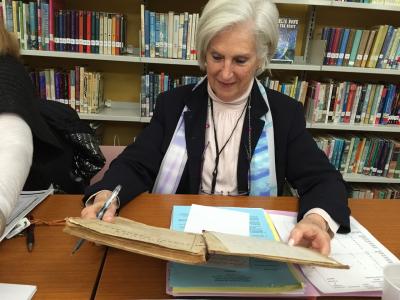Old Amagansett Schoolhouse Becomes Museum with First Donation

The original Amagansett schoolhouse was moved to the campus of the modern-day Amagansett School on Sept. 19, and ever since the ribbon-cutting ceremony that celebrated the old building's arrival, the school's administration has been working on turning it into a museum.
One of the centerpieces of that museum will be a geography textbook from 1863 once belonging to Joshua B. Edwards II when he was a student at the original Amagansett School. The district received that textbook, titled "Modern School Geography," as a donation from his son, Joshua B. Edwards III, who found the book in the attic of his father's house in October and immediately thought to donate it to the school. It was at that time that Jack Edwards, who had moved to Florida from Amagansett eight years ago, had the chance to see the old schoolhouse at its new location.
"I think it's going to be nice, really, something like that right on the school grounds," he said in a recent interview.
During the ribbon-cutting on Oct. 2, with students, teachers, members of the East Hampton Town Board, State Assemblyman Fred W. Thiele Jr., and the district's school board on hand, the spirit of community was strong as speakers emphasized the past as a guide to the present and future.
The one-room building, built in 1802 by Samuel Schellinger and donated to the district by Huntington and Adelaide Sheldon, on whose property it sat for decades, was originally on "Amagansett Street," now Montauk Highway. It was moved to the west side of Atlantic Avenue, at what is now the southern part of the East End Cemetery, in 1864, and moved again in 1881, when it was auctioned to Marcus Hand. Mr. Hand sold it to Capt. Joshua B. Edwards, who moved it across the street to his back yard, which is now part of the Sheldon property. There, the building was filled with fishing nets, a dory, and flensing knives, which were used to cut whale blubber.
Capt. Edwards's son, Dr. David Edwards, arranged the sale to Mr. Sheldon's mother, Magda Sheldon, in 1936 or '37. The building's last public use was for Girl Scout meetings in the late 1940s, Mr. Sheldon told The Star last year.
"It has traveled around the town over the past two centuries," Eleanor Tritt, the district superintendent, said, "and has finally landed at the spot where it best belongs." She told the student body that "under the gifted guidance of your teachers, you will be able to develop understanding about where it all began. . . . You can transport yourselves back to a time when your ancestors learned reading, writing, and arithmetic in a one-room schoolhouse, unheated, un-air-conditioned, with other students of all ages and abilities. And sometimes, they had to leave school to help their parents earn a livelihood, either through harvesting the bounties of land and sea, or from producing oil from captured whales."
"As you peer through the paneled windows, you can wonder if those students had any idea of what education would be like for you today. As we compare our two schools, representing education in the same place but separated by centuries, we have a wonderful tool for exploration."
The superintendent invited the community to contribute an item to a "treasure chest" that will be locked for the next 40 years. "Children, will you be here with your children to unlock the treasure chest?" she asked.
Ms. Tritt introduced East Hampton Town Supervisor Larry Cantwell, a graduate of the Amagansett School, who spoke of the "emotional rush" he experiences each time he returns. "This is about the sense of place," he said, "and how people care so much about the community, care so much about the history, and are willing to hang on to a sense that this building was important, that it shouldn't be changed, that someday it might become a gift back to Amagansett and be a public place."
The schoolhouse, Mr. Thiele said, "is one more gem added to that collection of what makes Amagansett great."
Hugh King, the East Hampton town crier who also is a graduate of the Amagansett School, spoke of other historic structures that have been preserved, including the 1902 Life Saving Station, nearby on Atlantic Avenue. "It's important to study history," Mr. King said, "because if you don't know where you've been, you might not know where you're going. But as Yogi Berra said, 'If you don't know where you're going, you may go someplace else.' "
"Isn't it good," Mr. King asked, "that the Amagansett 1802 schoolhouse has not gone someplace else?"
As the students rang bells to signify that class was once again in session, the ribbon was cut. The ceremony concluded with the students' singing John Howard Payne's "Home, Sweet Home."
"We can best chart our path to tomorrow by having ready access to our past," Ms. Tritt said. "We are all so fortunate that our community preserves and cherishes its past as a heritage for today's students, and those yet to come."
